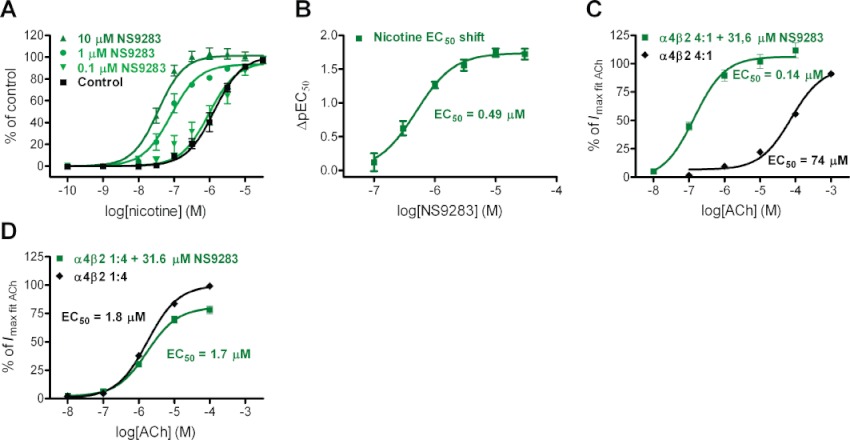Figure 2.

Allosteric modulation of α4β2 nACh receptors by NS9283 is conferred through increases in functional agonist potency. (A) NS9283 concentration-dependently leftward shifts the nicotine concentration–response (C–R) relationship for activating Ca2+-flux. Nicotine C-R relationships in HEK293-hα4β2 cells are shown under control conditions and at three concentrations of NS9283. Data points, baseline subtracted and normalized to the maximal nicotine (100 µM) effect, are presented as mean ± SEM of n= 4–6 experiments and are fitted to the Hill equation by non-linear regression. (B) Leftward shift in agonist C-R fully accounts for NS9283-induced modulation. The magnitude of the nicotine C–R leftward shift was quantified as the difference in log EC50 with and without NS9283 (ΔpEC50-value) and plotted as a function of NS9283 concentration. These C–R data for NS9283 were fitted well by the Hill equation. (C) NS9283 leftward-shifts the C-R relationship of ACh at the (α4)3(β2)2 nAChR in X. laevis oocytes. Oocytes were injected with α4 and β2 nAChR receptor subunits in a 4:1 ratio, and C–R relationships for ACh were determined in the absence and presence of NS9283 (31.6 µM) as data set pairs; that is, two 5-point ACh C–R relationships obtained for each oocyte, the first without and the second with NS9283. Data points, baseline subtracted and normalized to the maximal value obtained by fitting each oocyte ACh C-R to the Hill equation by non-linear regression, are presented as mean ± SEM of n= 12 experiments; and these were then fitted to the Hill equation by non-linear regression. (D) NS9283 does not alter the C–R relationship of ACh at (α4)2(β2)3 nAChR in X. laevis oocytes. Oocytes were injected with α4 and β2 nACh receptor subunits in a 1:4 ratio, and ACh C–R relationships were determined as described above. Data points were treated as described in (C) and are presented as mean ± SEM of n= 15 experiments.
